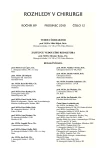-
Medical journals
- Career
Ambulatory Excision of Perianal Duplicatures
Authors: P. Zbořil; K. Vysloužil; I. Klementa; L. Starý; P. Skalický; V. Růžička
Authors‘ workplace: I. chirurgická klinika LF UP a FN Olomouc, přednosta: doc. MUDr. Č. Neoral, CSc.
Published in: Rozhl. Chir., 2010, roč. 89, č. 12, s. 774-779.
Category: Monothematic special - Original
Overview
For successful outpatient treatment of perianal duplicatures, it was necessary to solve two main problems. First was bleeding from wounds following excision of perianal duplicatures, which is often marked and „pulsating”, as well as to accelerate defect healing after excision so as to eliminate or minimize sick leave following this outpatient procedure. To effectively stop acute bleeding we use Traumacel powder, which after applying to a tampon we apply to the bleeding site and by compression we facilitate its effect. Traumacel spray also has a significant haemostatic effect, which we spray directly onto the bleeding site, where it reacts and creates a strongly adhering coagulum, which has significant haemostatic properties. This effect may also be potentiated by applying compression in the form of tampon or longuette.
After cessation of acute bleeding, as prevention against future seepage, surgical haemostatic materials are used, which adhere to the wound, or bleeding lesion, and are left in situ for approximately 12 hours. After stopping the bleeding, hydrocortisone and epithelializing cream is applied to the defects to support healing by significantly decreasing secretion from the wound and also significantly decreasing healing time by facilitating epithelization. At outpatient check-ups, wound surfaces treated as such are cleanly granulated without necrotic coating and with minimal surrounding redness. The total healing time is generally 2 weeks, whereas after 4 days the patients are almost without troubles. This effective healing not only lessens the patient’s pain, but also improves the comfort of the patient and allows a more rapid return to daily activities.
Sources
1. Aigner, F., Bodner, G., Gruber, H., Conrad, F., Fritsch, H., Margreiter, R., Bonatti, H. The vascular nature of hemorrhoids. J. Gastrointest. Surg., 2006 Jul-Aug; 10(7): 1044–1050.
2 Andromanakos, N., Arabi, Y., Alexander-Williams, J., Keighly, M. R. B. Anal pressures in hemorrhoids and anal fissure. Am. J. Surg., 1977; 134 : 608–610.
3. Bharucha, A. E. Pelvic floor: anatomy and function. Neurogastroenterol. Motil., 2006 Jul; 18(7): 507–519. Review.
4. Hancock, B. D., Smith, K. The internal sphincter and Lord’s procedur efor hemorrhoids. Br. J. Surg., 1975; 62 : 833–836.
5. Kairaluoma, M., Nuorva, K., Kellokumpu, I. Day-case stapled (circular) vs. diathermy hemorrhoidectomy: a randomized, controlled trial evaluating surgical and functional outcome. Dis. Colon Rectum, 2003 Jan; 46(1): 93–99.
6. Loder, P. B., Kamm, M. A., Nicholls, R. J., Philips, R. K. Haemorrhoids: patology, pathophysiology and etiology. Br. J. Surg., 1994 Jul; 81(7): 946–954.
7. Mattana, C., Coco, C., Manno, A., Verbo, A., Rizzo, G., Petito, L., Sermoneta, D. Stapled Hemorrhoidopexy and Milligan Morgan Hemorrhoidectomy in the Cure of Fourth-Degree Hemorrhoids: Long-Term Evaluation and Clinical Results. Dis. Colon Rectum, 2007 Aug.
8. Raulf, F. Functional anatomy of rectum and anus Hautarzt. 2004 Mar; 55(3): 233–239.
9. Shafik, A. The pathogenesis of hemorrhoids and their treatment by anorectal bandotomy. J. Clin. Gastroenterol., 1984; 6 : 129–137.
Labels
Surgery Orthopaedics Trauma surgery
Article was published inPerspectives in Surgery

2010 Issue 12-
All articles in this issue
- Rare Umbilical Anomalies
- Potential of Endoscopic Microsurgery
- Ambulatory Excision of Perianal Duplicatures
- Patient Survival Following Radiofrequency Ablation of Liver Metastases from Colorectal Cancer
- XLIF – A New Technique of the Lumbar Vertebra Replacement: Initial Experience
- Radical Procedures in Patients with Pancreatic Cancer – Impact on Prolongation and Quality of Life
- Pancreatic Cancer Surgery at Ist Surgical Clinic of the Olomouc Faculty Hospital (FN Olomouc)
- Esophageal Replacement Using Large Intestine – Experience with 109 Cases
- Video-Assisted Esophageal Resection for Carcinoma – Ten-Year Experience
- Solitary Fibrous Tumor of Pleural Cavity
- Risk of Colorectal Carcinoma in a Patient with Ulcerative Colitis
- An Original Reconstruction of Stomach after Gastrectomy for Cancer
- Perspectives in Surgery
- Journal archive
- Current issue
- Online only
- About the journal
Most read in this issue- Rare Umbilical Anomalies
- Ambulatory Excision of Perianal Duplicatures
- Solitary Fibrous Tumor of Pleural Cavity
- XLIF – A New Technique of the Lumbar Vertebra Replacement: Initial Experience
Login#ADS_BOTTOM_SCRIPTS#Forgotten passwordEnter the email address that you registered with. We will send you instructions on how to set a new password.
- Career

